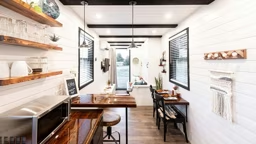
What color should your cabin be, inside and out? Will you try to blend with the natural environment around your cabin? Do you want to set your cabin apart from all the beige vinyl-sided cabins along your beach?
There are so many options: the color of birch bark for the trees outside your cabin, moss green as found on boulders near your lakeshore, hazel like your spouse’s eyes, or International Harvester red for your favorite toy tractor collection.
In most locations, you’ll have unlimited choices as to the exterior color you select, whether it be pumpkin orange or lime green. You may receive the wrath of neighbors, but most likely they won’t have legal recourse.
However, some cabin development sites come with covenants that may dictate the exterior look of your retreat. In these instances, your homeowners, lake or land association has the final say regarding the look of your exterior. They may not agree that although the Lady Slipper, Minnesota’s state flower, is found to be pink in nature, that it should be the color of your cabin.

I have a predilection for suggesting colors found at the sites of my clients’ cabins, and after a visit to the site, I often bring back to my office various natural colored elements, such as creamy or silver white birch tree bark, deep red sumac twigs, soft green lichen or the accent color of blueberries. Or, I sometimes draw from the historic exterior cabin colors of white, barn red or creosote brown. The latter is one of my favorites, as it was a popular wood preservative on log structures and lodges a century ago, and this color subdues the cabin into its natural setting, which can make the cabin appear smaller in its surroundings.
If I’m designing a cabin with artistic focal points, I take a note from author and design expert, Inger McCabe Elliott, of whom I’m a fan. In her book, “Exteriors,” she states: “Color is a form’s companion, enhancing shapes that otherwise might be lost.”
For interior colors, I’m usually looking for something to integrate with the wood species we’re specifying, whether we’re selecting a floor tile (such as multicolored Vermont Slate), staining wood with color or painting drywall a color. Color inside a cabin sets a mood for the space, and many clients restrain from overt color choices other than wood walls and only add brilliant color in bedspreads, dishes, towels and artwork.
When determining color for your cabin, here are some considerations.

Exterior
Siding and Trim
Many siding and trim materials – including cement siding, metal siding and composite materials – are now available in a wide variety of prefinished hues and colors, predominately in white, red, taupe, tan, gray, caramel or brown.
Natural Wood
Natural wood products, such as cedar shingles and trim, pine lap siding or exterior-grade plywood, can be stained a variety of tones or left to weather gray. If you stain, keep in mind that the more color pigment in the stain, the more often you’ll need to re-stain to keep it looking sharp.
Metal Roofs
Metal roofs are available in a wide variety of paint colors, but there’s also natural copper, zinc or rusted steel. Bright colors will fade; copper goes through a color transformation; and rusting steel needs to be kept away from adjacent materials that it can discolor.
Asphalt Shingles
Asphalt shingles are more limited in color options, and you’ll need to check with national brands to see which colors are available in your locale. In addition to gray, tan, brown and charcoal, the colors of red and green are usually at your local lumberyard. See also Exterior Finishes at the Cabin
Windows
Windows used to be only supplied in white, tan and bronze, and that is still the case with lower cost brands. However, major brands such as Andersen, Marvin, Colby and others each have a wide variety of colors at no upcharge. The Andersen E-Series has 50 colors to choose from in both doors and windows.

Interior
Get Organized
Begin your interior selection with the materials you’re most committed to, such as the pine plank floor, the taconite stone fireplace or the green/gray slate tile, and then work to infill with colors where you have more choice, such as painted walls. Creating a chart listing all rooms and their major surfaces will help you keep track of your decisions.
Add Contrast
Consider adding some contrast through washing a color into some wood paneling or milk painting or stenciling a wall with birds in flight.
Get Help
Ask your architect for assistance. An architect in Oregon had his client’s family hand paint tiles from which he created an inglenook as a remembrance.
Find Inspiration
Look at treasures you own and love. Your grandmother’s quilt may provide you with all the color choices for your cabin’s interior.
Acquire Samples
Test your colors by acquiring samples of the actual material you plan to use and then build a pallet of this collection, so you can attest to compatibility. When selecting a wall color, hold the sample vertically. A ceiling color should be held upside down.
View in Natural Light
All colors should be viewed in indirect natural light and not the florescent light of a big box store. Note: Color samples found online are often quite different when viewed in real time.
Are you a color expert? I’d like to think I am, but each morning when my wife sees my wardrobe selection, she has her doubts. Have fun with your choices and enjoy making your cabin a rich array of your favorite colors.
ABOUT OUR AUTHOR Dale Mulfinger regularly designs cabins with Minnesota-based SALA Architects, teaches cabin classes and gives talks on cabin design across North America. He has authored five cabin-centric books.










